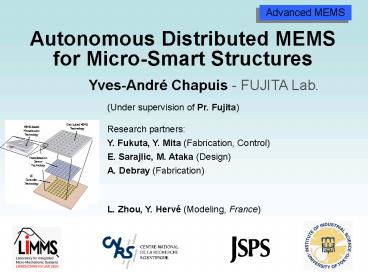Autonomous Distributed MEMS for MicroSmart Structures - PowerPoint PPT Presentation
1 / 7
Title:
Autonomous Distributed MEMS for MicroSmart Structures
Description:
Integration of MEMS, Electronics, Intelligence (IC, sensors, controller) ... ( 4) An artificial, ferromagne-tic opal prepared by tem-plated self-assembly of ... – PowerPoint PPT presentation
Number of Views:35
Avg rating:3.0/5.0
Title: Autonomous Distributed MEMS for MicroSmart Structures
1
Autonomous Distributed MEMS for Micro-Smart
Structures
Yves-André Chapuis - FUJITA Lab.
(Under supervision of Pr. Fujita)
Research partners Y. Fukuta, Y. Mita
(Fabrication, Control) E. Sarajlic, M. Ataka
(Design) A. Debray (Fabrication)
L. Zhou, Y. Hervé (Modeling, France)
2
Needs
- Integration of MEMS, Electronics, Intelligence
(IC, sensors, controller) - 3-D Hybride Integration (smaller microsystem
size) - Large Scale Integration MEMS (for distributed
microsystems on-chip) - Low-Cost Packaging Technology (Flip-Chip,
self-assembly, system-on-PCB, ..) - Use of Smart Materials (polymers, specific
solders)
No Needs
- To Develop Unique and Complexe Fabrication
Process (flexible solutions for hosting
microsystems)
3
What is Smart Technology?
Scientific Context
Smart Technology a Emerging Field
- Not only one definition Today a system should
be Adapting, Sensing, Unferring, Learning,
Anticipating, Self-Organizing
Walter DERZKO, 2006
- The use of MEMS in smart systems is so intensely
intertwined that these technologies are often
treated as two faces of the same coin .
Vijay K. Varadan, et al., Smart material
systems and MEMS (2006)
4
Scientific Context
List of exemples of smart technology
Applications of self-assembly. (1) A 2 by 2
cross array made by sequential assembly of
nanowires. (2) Diffraction grating formed on
the surface of a poly(dimethylsilo-xane) sphere.
(3) 3-D electronic circuits self assembled from
milli-metersized polyhedra with electronic
components (LEDs). (4) An artificial,
ferromagne-tic opal prepared by tem-plated
self-assembly of polymeric microbeads.
M. B. Cohn, K. F. Bohringer, Jet al.,
Microassembly technologies for MEMS, SPIE
Micromachining and microfabrication Symposium,
1998
U. Srinivasan, et al., Selected Topics in Quantum
Electronics, IEEE Journal of, 8, 4-11 (2002).
H. O. Jacobs, A. R. Tao, A. Schwartz, D. H.
Gracias and G. M. Whitesides, Science, 296,
323-325 (2002).
C. J. Morris, S. A. Stauth and B. A. Parviz, IEEE
Transactions on Advanced Packaging, 28, 600-611
(2005).
E. P. Quevy, R. T. Howe et al. Reconstituted
wafer technology for heterogeneous integration,
MEMS'06, 2006
5
Our Objectifs
- Smart Surface Device
- 3-D Multi-Layer Integration
- (MEMS/Sensors/Controllers )
- Use of Capillarity Forces
- (for self-assembly)
- Paste Liquid Solder Technology
- Reliable Process
- (no functional dommaging)
- Generic Approach
- (for multi-actuation/electronic technology )
6
Our Approach Smart Surface
Flip-Chip approach using Self-Assembly technique
Flip-Chip, self-alignment, and assembly
techniques are elaborated by patterning
hydrophobic/hydrophylic area on the electronic
chip sur-face, then by warming the device to make
contact between electrodes MEMS and solder bumps.
7
State of Research
Self-alignement Permanent Assembly
New Process Approach3-D Large Scale Integration
of MEMSusing capillarity force for alignment
assembly process
Achieved
3 Level Integration using Through Hole Wafer
Technology
in Progress
Bump solder technique (Paste liquid solders)
- Low-cost Technology
Achieved
- Flexible Extensible Technology































